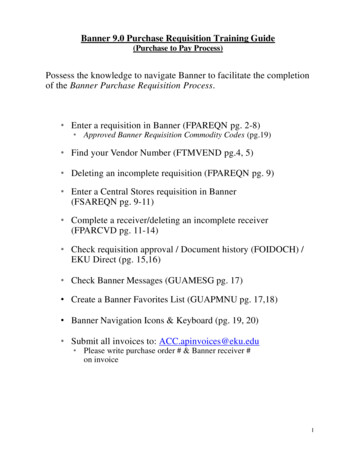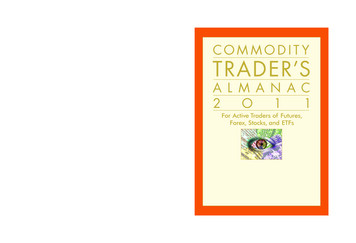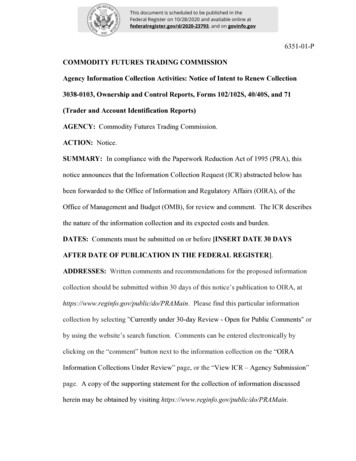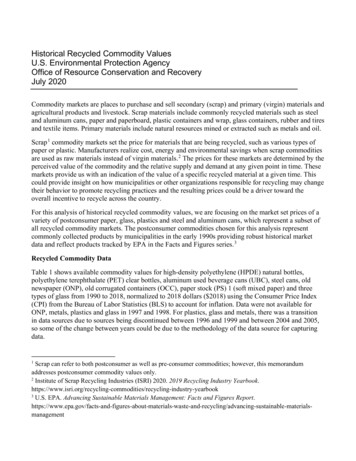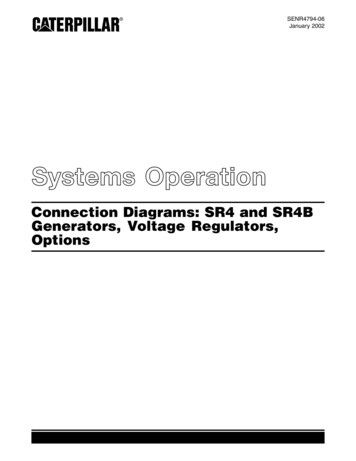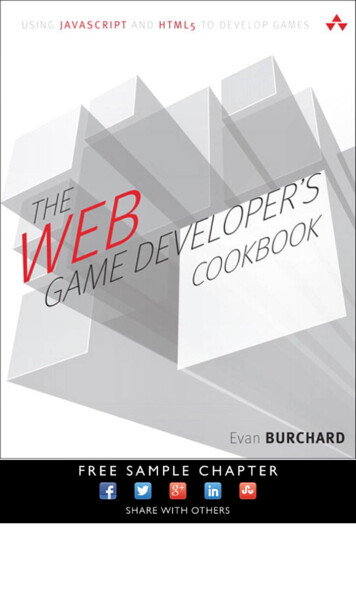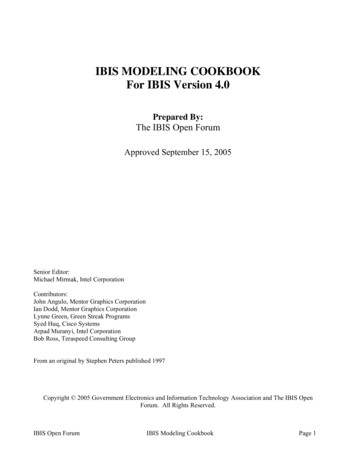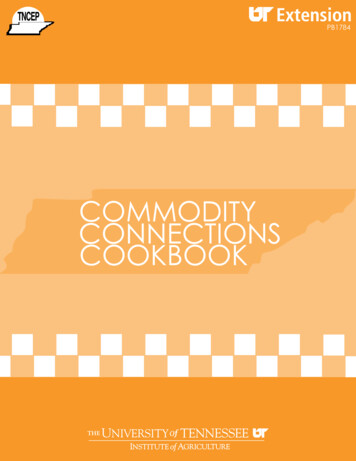
Transcription
PB1784COMMODITYCONNECTIONSCOOKBOOK
ContentsINTRODUCTION6Commodity Foods6Kitchen Connections6TOOLS FOR COOKING CONNECTIONS7FOOD SAFETY10Temperature Chart for Protein Foods10Refrigerator and Freezer Storage Chart11HEALTHFUL COOKING13NUTRITION FACTS LABELS15BREADS16Applesauce-Date Loaf17Applesauce Muffins18Oatmeal Apple Muffins19Peanut Butter Bread20Spicy Applesauce Nut Bread21BREAKFAST22Applesauce Pancakes23Breakfast BOP24Peachy Yummy Smoothie25DESSERTS26Apple Bread Pudding27Big Orange Pudding28
Orange & White Salad29Peanut Butter Cereal Bars30Pear ‘N’ Apple Cobbler31MAIN DISHES32Autumn Pork Stew33Bar-B-Q-Cups34Beans and Rice with Meat35Beef Stroganoff36The Everything Casserole37Corn Bread Burger Bake38Crunchy Tuna Salad Wraps39Enchilada Rice40Goulash41Pork & Cheese Macaroni42Pork & Lentils43Salmon Cornmeal Muffins44South of the Border Wraps45Stir-Fry Chicken & Vegetables46Sweet & Sour Barbeque47SIDES48Applesauce Sweet Potatoes49Carrot-Raisin Salad50Corn Bread Salad51
Creamy Green Beans52Crunchy Potato Bake53Escalloped Tomatoes54Orange-Raisin Rice55Pasta Primavera56Spanish Rice57Spicy Mexican Corn58Three Bean Salad59SOUPS60Chicken Corn Chowder61Crock-Pot Taco Soup62
IntroductionThe Commodity Connection Cookbook has been compiled and distributed by theTennessee Nutrition and Consumer Education Program (TNCEP) with University of Tennessee Extension. The recipes presented in this book use foods that are a part of thecommodity food package that is distributed through the United States Departmentof Agriculture (USDA). County Extension agents and program assistants from acrossTennessee shared some of their favorite recipes to make this cookbook possible. Therecipes were then compiled and adjusted by a registered dietitian to ensure that thecookbook provides the most useful and healthful recipes possible.Commodity FoodsThe federal government works to support farming efforts and to protect food pricesby purchasing extra food grown by American farmers. For example, if farmers have agood season growing tomatoes, the USDA will purchase the extra tomatoes. The tomatoes are processed, packaged and distributed across the country to a variety ofnutrition programs and eligible families. By doing so, the government prevents extra tomatoes from going to waste and helps keep tomato prices reasonable for farmers andconsumers. Commodities are high quality, nutritious foods that can be a wonderfulsupplement to any diet. Many of the recipes in this book use two or more commodityfoods to help families get the most out of the commodity food package. Commodityfood items listed are in bold and italicized on each recipe to make each commodityfood easy to use and good to eat.Kitchen ConnectionsThe kitchen could be called the most important room in the house, since it is wherefamilies prepare and share foods to nourish their bodies. The kitchen provides a settingfor families to experience all the wonderful sensations related to preparing and eating food together. The look, feel, sound, smell and taste of foods create experiencesand memories that will last a lifetime. With all the wonder the kitchen has to offer, it isimportant to stay focused on keeping it as safe and clean as possible. For this reason,the first step of each recipe in this cookbook is to “Wash hands.” Then make sure allsurfaces that touch food are clean at the beginning of the cooking process and keepthem clean throughout.Wash hands before and after touching raw foods like meat, poultry, eggs and seafood. These foods may contain harmful bacteria that can spread from hands, knives,cutting boards and countertops to other foods. By hand washing and cleaning anykitchen tools with hot, soapy water, many food-borne illnesses can be prevented. Helpmaintain a positive cooking experience by being attentive to situations that couldlead to cuts or burns. Never place a sharp knife in a sink filled with water and keep pothandles turned away from the edge of the stove to keep everyone safe in the kitchen.6
Tools for Cooking ConnectionsHere are some examples of kitchen tools or equipment usedmost often in this cookbook.Dry Measuring Cups: These are used for measuring dry ingredients like flour and sugar. For the most accurate measurement, fill the cup to the top and level with the flat edge of adinner knife.Liquid Measuring Cups: These are used for measuring liquidor wet ingredients like water, milk or oil. For the most accuratemeasure, place measuring cup on a level surface, fill to theneeded amount line, and read the measurement ateye level.Measuring Spoons: These are used to measure both liquidand dry ingredients. For the most accurate measure for liquids, fill the measuring spoon to the top. When measuringdry ingredients it is important to follow the recipe instructions.The recipe may call for a level tablespoon that would requireleveling the ingredient with a flat edge as with dry measuringcups. Other recipes may call for a “heaping” or a “rounded”tablespoon, for example, which means the spoon is filled witha mound or a heap of the ingredient in the spoon.Blenders: These are versatile small appliances that can beuseful in any kitchen. The “Ice” or “Chop” setting is ideal formaking milkshakes, smoothies or frozen drinks. The “Pulse” setting can be used to make bread crumbs, chop vegetablesand make cracker crumbs. It is important to properly cleanthe pitcher after each use. To clean it quickly and easily, fillhalfway with warm water, add a drop of dishwashing detergent, put on the blender and run on low speed for a fewseconds. Rinse the pitcher and the lid well. Take apart theblade section, rinse and dry the blades and the rubber gasket. Reassemble and store.Graters or shredders: For easy clean-up, spray the graterwith nonstick cooking spray before use. Grate food by pushing the food in a downward motion over the holes. Take careto avoid grating knuckles and fingertips. Rinse the grater inhot water immediately after use to avoid sticking. If food isdifficult to remove, soak in hot water, then scrub with acleaning brush.7
ToolsColander: Colanders are used to drain liquids and fat fromfoods easily and safely. Use caution when draining hot foodslike cooked pasta. Be sure to keep out of the way of thesteam that will rise quickly as the food is being poured intothe colander. Pour cooked foods into the colander slowly toavoid splashing hot liquids.Sauce pan: Recipes in this cookbook recommend usingsmall, medium or large sauce pans. Sauce pans are typicallydeeper than skillets, have long handles on one side and havelids. Again, make sure to keep those handles turned to theback of the stove to keep little hands from tipping them over.Casserole dish: Recipes in this cookbook are identified assmall, medium or large. The casserole dish pictured is a largecasserole dish. Some recipes may call it a 9-by-13-inch dish ora 2-quart pan. Casserole dishes are glass or metal and maycome with a baking lid. If the recipe calls for the dish to becovered for part of the baking time and you do not have alid, just cover with a piece of aluminum foil.If the exact size pan or dish is not available, other sizes canbe used, but the recipe will have to be adjusted. For example, if a recipe calls for a large casserole pan and only around baking pan is available, no problem. Since the pan issmaller than the pan recommended, the casserole should bethicker and will probably need to cook longer than recommended on the recipe.Muffin pan: These pans are typically metal or silicon and canbe used with or without paper muffin liners. Muffin pans comein several sizes from large muffins and to mini-muffins that aregreat for little hands.Loaf pan: These loaf or bread pans can be metal, glass,ceramic or silicon. They can help maintain the shape of abaked food, such as bread or meatloaf. Look for a loaf panwith 3-inch-high sides with extended edges for easy handling.A darker, nonstick finish is a fine choice, too, since corn breadand other quick breads benefit from a deep, golden crust.8
ToolsFood Thermometers: Food or meat thermometers can takethe guesswork out of cooking, since knowing when foodcooked to a safe temperature can be difficult. Most recipesgive a time range to cook or bake the food, but checkinginternal temperature is the best way to make sure the food issafe to eat. Food thermometers can be found in the bakingsection of any department store. Use the thermometers whencooking meat and poultry or any casserole to ensure that thefood has reached a temperature high enough to kill harmfulbacteria. Wash the thermometer with hot, soapy water andrinse after each use.Cutting Boards: Boards must be washed with hot, soapywater before cutting different raw foods. Ideally, a differentcutting board should be used for each food being prepared.Never prepare any raw meat, poultry or seafood on a cuttingboard that has already been used. If possible, use a differentcutting board for raw meat, poultry and seafood products.Always wash your hands, utensils, countertops and cuttingboards after they come in contact with raw meat, poultryor seafood.9
Food SafetyCooking food – especially raw meat, poultry, fish and eggs – to a safe minimum internal temperature kills harmful bacteria. Thoroughly cook food as follows*:Temperature Chart for Protein FoodsRAW FOODGround ProductsBeef, veal, lamb, porkChicken, turkeyBeef, Veal, Lamb Roasts and SteaksMedium-rareMediumWell-donePork Chops, roast, ribsMediumWell-doneHam, fully cookedHam, freshSausage, freshPoultry (turkey and chicken)Whole birdBreastLegs and thighsStuffing (cooked separately)EggsFried, poachedCasserolesSauces, custardsFishINTERNAL TEMPERATURE160 F165 F145 F160 F170 F160 F140 F170 F160 F160 F165 F165 F165 F165 Fyolk & white are firm160 F160 Fflakes with a fork*This chart provides guidance for cooking foods at home.At room temperature, bacteria in food can double every 20 minutes. The more bacteria there are, the greater the chance you could become sick. So, refrigerate foodsquickly because cold temperatures keep most harmful bacteria from multiplying. A lotof people think it will harm their refrigerator to put hot food inside – it's not true. It won'tharm your refrigerator and it will keep your food – and you – safe. Set your home refrigerator to 40 F or below and the freezer unit to 0 F or below. Check the temperatureoccasionally with an appliance thermometer.10
Refrigerator & Freezer Storage ChartRefrigerator (40 F) Freezer (0 F)EggsFresh, in shellHard cookedEgg substitutes, openedEgg substitutes, unopened4-5 weeks1 week3 days10 daysDon’t freezeDoesn’t freeze wellDon’t freeze1 yearDairy ProductsMilkCottage cheeseYogurtCommercial mayonnaise (refrigerate afteropening)1 week1 week1-2 weeks2 months3 monthsDoesn’t freeze well1-2 monthsDon’t freezeVegetablesBeans, green or waxedCarrotsCeleryLettuce, leafLettuce, icebergSpinachSquash, summerSquash, winterTomatoesRaw3-4 days2 weeks1-2 weeks3-7 days1-2 weeks1-2 days4-5 days2 weeks2-3 daysBlanched/cooked8 months10-12 months10-12 monthsDon’t freezeDon’t freeze10-12 months10-12 months10-12 months2 monthsDeli FoodsEntrees, cold or hotStore-prepared or homemade salads3-4 days3-5 days2-3 monthsDon’t freezeHot Dogs and Luncheon MeatsHot dogs, opened packageHot dogs, unopened package1 week2 weeksLunch meats, openedLunch meats, unopened3-5 days2 weeksTV Dinners/Frozen CasserolesKeep frozen until ready to serveFresh MeatBeef steaks, roastsPork chops, roastsLamb chops, roastsVeal-roast1-2 months infreezer wrap1-2 months1-2 months3-4 months3-5 days3-5 days3-5 days3-5 days6-12 months4-6 months6-9 months4-6 months11
Refrigerator & Freezer Storage ChartRefrigerator (40 F) Freezer (0 F)Fresh PoultryChicken or turkey, wholeChicken or turkey, pieces1-2 days1-2 days1 year9 monthsFresh FishLean fish (cod, flounder, etc.)Fatty fish (salmon, etc.)1-2 days1-2 days6 months2-3 monthsHamCanned ham (label says “keep refrigerated”) 6-9 monthsHam, fully cooked (half & slices)3-5 daysDon’t freeze1-2 monthsBacon and SausageBaconSausage, raw (pork, beef or turkey)Precooked smoked breakfast links/patties1 week1-2 days1 week1 month1-2 months1-2 months3-4 days2-3 months1-2 days3-4 days2-3 months4-6 monthsLeftoversCooked meat, meat dishes, egg dishes,soups, stews and vegetablesGravy and meat brothCooked poultry and fishAdapted from National Institutes of Health “Heart Healthy Cookbook.”12
Healthful CookingMaking small changes in the kitchen can add up to big gains in your health. But whosaid you have to sacrifice taste for nutrition? Try the following tips and substitutions tomake meals you serve healthier.TryWhen sautéing onion for flavoringstews, soups and saucesWhen making a salad dressingWhen making chocolate dessertsWhen making cakes and soft dropcookiesWhen making muffins, quick breads orbiscuitsWhen making muffins or quick breadsWhen baking or cookingWhen making pie crustWhen you need sour creamWhen a recipe calls for butterTo cut saturated fatInstead ofUse nonstick spray, water or stock.Use equal parts water and vinegar and halfas much oil. To make up for less intense flavor, add more mustard and herbs.Use 3 tablespoons of cocoa instead of 1ounce of baking chocolate (if fat is needed to replace the fat in chocolate, add 1tablespoon or less of vegetable oil).Use no more than 2 tablespoons of fat foreach cup of flour.Use no more than 1-2 tablespoons of fatfor each cup of flour. Substitute half wholewheat flour for white flour.Use three ripe, very well mashed bananasor 1 cup applesauce instead of 1 cup butter or oil (you will get less saturated fat andfewer calories).Use three egg whites and one yolk insteadof two whole eggs; or instead of one wholeegg use two egg whites or ¼ cup of eggsubstitute.Use only ½ cup margarine for every 2 cupsof flour.Mix 1 cup low-fat cottage cheese with 1tablespoon skim milk and 2 tablespoonslemon juice; substitute plain, nonfat or lowfat yogurt; or try some of the reduced-fatsour cream substitutes.Choose soft margarine with liquid vegetable oil instead of hydrogenated or partiallyhydrogenated shortening oil as the firstingredient listed on the label.Use regular soft margarine made with vegetable oil instead of butter or lard. In general, diet margarine should not be used inbaking.13
Healthful CookingTryBroiling, steaming, roasting/baking, microwaving, grilling, braising/stewing, boiling,simmering or stir-frying with a little bit of oilLean meats such as round, sirloin, chuckarm pot roast, loin, lean and extra-leanground beefChicken and turkey with skin removedBaked or broiled fish, tuna packed inwaterBeans made with smoked turkey partsSmall amount of vegetable oilTurkey bacon, lean ham, Canadian baconGround turkey breastLow-fat or fat-free milkLow-fat or part-skim milk cheese (checklabels)Evaporated skim milkMustard, low-fat mayo and salad dressingVegetables prepared without added fatLow-sodium bouillon and brothInstead ofFrying, basting with fat, cooking in fattysauces and graviesRegular ground beefFried chickenFried fish, tuna packed in oilBeans made with lard, ham hocks or baconLard, butter or other fats that are solid atroom temperaturePork, bacon or sausageGround beef or porkWhole milk or 2% milkWhole-milk cheesesCreamRegular mayo and creamy salad dressingVegetables made with butter or seasoned with fatty meatsRegular bouillon and brothAdapted from National Institutes of Health “Heart Healthy Cookbook.”14
Nutrition Facts LabelsNutrition facts labels have been included with each recipe in this cookbook to helpyou as you plan meals. The nutrition facts label allows you to compare foods based onthe food's key nutrients. When comparing foods, focus on those nutrients that are important to you. If you are concerned about your weight concentrate on the amountof total calories you will get from eating one portion of that food. If you are concernedabout blood pressure for example, you should pay attention to the amount of sodiumin that food. On the right side of the nutrition facts label, you will find percentages ofnutrients based on a 2,000 calorie diet. This 2,000 calorie diet is based on a standarddiet and may be too many calories or not enough calories for you. If you would like tofind out how many calories, food portions and amount of activity you need each day,you can go to www.MyPyramid.gov for a personalized nutrition plan designed just foryou.1. Star t Here Ever ything on thislabel is specific tothis ser ving size.3. Limit theseNutrients4. Get Enough ofThese Nutrients5. Footnote - Thispor tion of the labelshows the dailygoal of severalnutrients basedon a 2,000 or 2,500calorie diet.2 . C h e c k t h e Ca l o r i e s- This tells you howm a ny c a l o r i e s yo uwill be consuming ifyou eat the ser vings i ze. “Ca l o r i e s f ro mFat ” shows you howmuch of the caloriecontent comes fromfat.6. Daily Values M adeEasy - I f the % DailyValue of a nutrientis less than 5%, thefood is low in thatnutrient. I f the %Daily Value is 20% orgreater, the food ishigh in that nutrient.Nutrients with no% Daily Value listeddo not have a setrecommendation forthe amount to eat inone day.15
BREADS
APPLESAUCE-DATE LOAFRecipe Recommended by Carroll County Extension.Ingredients:½ cup butter² ³ cup sugar1 egg1 teaspoon vanilla2 cups all-purpose flour1 teaspoon baking powder1 teaspoon baking soda½ teaspoon cinnamon¼ teaspoon nutmeg1½ cups applesauce1 cup finely diced dates½ cup finely diced pecansInstructions:1. Wash hands and clean food preparation area.2. Preheat oven to 350 degrees.3. Spray loaf pan with nonstick cooking spray.4. With mixer, cream butter and sugar until fluffy, in mediummixing bowl.5. Blend in egg and vanilla.6. Sift together flour, baking powder, baking soda, cinnamonand nutmeg in a medium bowl.7. Take turns adding small parts of flour mixture and applesauceto butter mixture.8. Stir in dates and pecans just until mixed to avoid over-mixing.9. Bake about 1 hour or until bread pulls away from sides of pan.10. Cool in pan 20 minutes.11. Remove from pan and cool on rack.Makes 12 (one-slice) servings.Commodity Connection Recipe Tip: Glass bakeware retains heatbetter than metal baking pans. If you are using glass, reduce thetemperature of your oven to 325 degrees to prevent over-baking.Programs in agriculture and natural resources, 4-H youth development, family and consumer sciences, and resource development. University of Tennessee Institute of Agriculture, U.S. Department of Agriculture, and county governments cooperating. UT Extensionprovides equal opportunities in programs and employment.17
APPLESAUCE MUFFINSRecipe Recommended by Carroll County Extension.Ingredients:4 cups all-purpose flour1 tablespoon cinnamon1 tablespoon ground allspice2 teaspoons baking soda½ cup butter2 cups sugar2½ cups applesauce2 eggs2 tablespoons vanilla1 cup raisinsInstructions:1. Wash hands and clean food preparation area.2. Preheat oven to 350 degrees.3. Spray muffin pan with nonstick cooking spray or use papermuffin cups.4. In a medium mixing bowl, combine flour, cinnamon, allspiceand baking soda.5. In another bowl, use mixer to cream butter and sugar.6. Blend eggs, applesauce and vanilla into butter mixture.7. On low speed, slowly blend flour mixture into butter mixtureuntil moistened, do not over-mix.8. Fold in raisins using mixer on low speed.9. Fill each muffin cup ¾ full.10. Bake for 20 minutes or until muffins turn golden brown.11. Cool in pan 10 minutes then remove to wire rack.Makes 24 (one-muffin) servings.Commodity Connection Recipe Tip: The term “fold” is a way tostir or mix lighter ingredients into heavier ones. To fold a mixture,stir with a spoon or a spatula in a cutting or slicing J-shapedmovement, lifting up as you go. Just make sure not to fold toomuch. Folding helps to keep the mixture light and fluffy.18Programs in agriculture and natural resources, 4-H youth development, family and consumer sciences, and resource development. University of Tennessee Institute of Agriculture, U.S. Department of Agriculture, and county governments cooperating. UT Extensionprovides equal opportunities in programs and employment.
OATMEAL APPLE MUFFINSRecipe Recommended by Fentress County Extension.Ingredients:1½ cups oats1¼ cups self-rising flour¾ teaspoon cinnamon1 cup applesauce3 tablespoons instant nonfat dry milk powder¾ cup water½ cup brown sugar2 tablespoons canola oil1 eggInstructions:1. Wash hands and clean food preparation area.2. Preheat oven to 400 degrees.3. Spray muffin pan with nonstick cooking spray or use papermuffin cups.4. Combine oats, flour and cinnamon.5. Add applesauce, instant nonfat dry milk, brown sugar, water,oil and egg.6. Mix until moistened.7. Fill muffin cups about ¾ full.8. Bake for 20 minutes or until golden brown.9. Cool in pan 10 minutes then remove to wire rack.Makes six (one-muffin) servings.Commodity Connection Recipe Tip: When baking muffins, themixing time is very important. Over-mixing muffin batter will causethe muffins to rise into sharp peaks. Only mix until the batter ismoistened for soft, rounded tops and compact, tender texture.Programs in agriculture and natural resources, 4-H youth development, family and consumer sciences, and resource development. University of Tennessee Institute of Agriculture, U.S. Department of Agriculture, and county governments cooperating. UT Extensionprovides equal opportunities in programs and employment.19
PEANUT BUTTER BREADRecipe Recommended by Greene County Extension.Ingredients:2¼ cups self-rising flour¾ cup sugar½ cup instant nonfat dry milk powder1¾ cups water1 teaspoon vanilla½ cup peanut butterInstructions:1. Wash hands and clean food preparation area.2. Preheat oven to 350 degrees.3. Spray loaf pan with nonstick cooking spray.4. In small mixing bowl, combine flour, instant nonfat dry milkpowder and sugar together.5. Using a mixer, blend water, vanilla and peanut butter.6. Slowly blend in flour mixture with the peanut butter mixtureuntil smooth.7. Pour mixture in loaf pan.8. Bake for 45 minutes.9. Allow to cool before removing from pan.Makes 12 (one-slice) servings.Commodity Connection Recipe Tip: When measuring thick, stickyingredients (molasses, honey, peanut butter), try spraying themeasuring cups and spoons with nonstick spray first (justlightly). The ingredients will come out easier.20Programs in agriculture and natural resources, 4-H youth development, family and consumer sciences, and resource development. University of Tennessee Institute of Agriculture, U.S. Department of Agriculture, and county governments cooperating. UT Extensionprovides equal opportunities in programs and employment.
SPICY APPLESAUCE NUT BREADRecipe Recommended by Lawrence County Extension.Ingredients:½ cup chopped dates² ³ cup chopped walnuts2 cups self-rising flour1 cup sugar1 teaspoon cinnamon½ teaspoon nutmeg1 cup applesauce¹ ³ cup orange juice1 egg, beaten1 tablespoon canola oilInstructions:1. Wash hands and clean food preparation area.2. Preheat oven to 350 degrees.3. Spray loaf pan with nonstick cooking spray.4. Chop dates and nuts.5. In medium mixing bowl, combine flour, sugar,cinnamon and nutmeg.6. In separate bowl, mix applesauce, orange juice, egg andcanola oil.7. Stir in dates and walnuts to applesauce mixture.8. Slowly add small amounts of flour mixture toapplesauce mixture.9. Mix well.10. Pour batter into loaf pan.11. Bake for 50 to 60 minutes.12. Allow to cool before removing from pan.Makes 12 (one-slice) servings.Commodity Connection Recipe Tip: Preheating your oven is essential for baking. Baking in a hot oven gives foods like breads andcookies important characteristics that make them look and tastegood. The first 10 minutes in a preheated oven helps breads to riseand form a crust.Programs in agriculture and natural resources, 4-H youth development, family and consumer sciences, and resource development. University of Tennessee Institute of Agriculture, U.S. Department of Agriculture, and county governments cooperating. UT Extensionprovides equal opportunities in programs and employment.21
BREAKFAST
APPLESAUCE PANCAKESRecipe Recommended by Loudon County Extension.Ingredients:1 cup applesauce¼ cup instant nonfat dry milk powder1 cup water2 eggs1 tablespoon canola oil2 cups all-purpose flour2 tablespoons sugar1 teaspoon cinnamon2 tablespoons baking powderInstructions:1. Wash hands and clean food preparation area.2. In a medium mixing bowl, combine applesauce, instantnonfat dry milk powder, water, eggs and oil.3. Add flour, sugar, cinnamon and baking powder.4. Stir until mixture has only small lumps.5. Place large skillet on medium-high heat.6. Spray skillet with nonstick spray.7. Pour ½ cup batter into skillet.8. Turn pancake when bubbles form on top of batter.9. Cook other side for about 1 minute or until golden brown.Makes six (6-inch) servings.Commodity Connections Recipe Tip: Warm a cup of applesauceand pour over your pancakes instead of using maple syrup. Doingso will add some more wonderful apple flavor while saving about150 calories.Programs in agriculture and natural resources, 4-H youth development, family and consumer sciences, and resource development. University of Tennessee Institute of Agriculture, U.S. Department of Agriculture, and county governments cooperating. UT Extensionprovides equal opportunities in programs and employment.23
BREAKFAST BOPRecipe Recommended by Loudon County Extension.Ingredients:½ cup oats¼ cup instant nonfat dry milk powder1 cup water1 banana2 tablespoons peanut butterInstructions:1. Wash hands and clean food preparation area.2. In a single-serving microwave-safe bowl, mix oats with instantnonfat dry milk powder and water.3. Cook in microwave for 3½ minutes.4. Carefully remove bowl from microwave.5. Mix in the peanut butter.6. Slice banana on top and serve.Makes one serving.Commodity Connections Recipe Tip: Breakfast is the most important meal of the day. Don’t skip breakfast because you arealways rushed in the morning. Adding peanut butter to yourbreakfast adds protein. Protein is important for building healthytissue, such as muscle, and helps keep hunger away.24Programs in agriculture and natural resources, 4-H youth development, family and consumer sciences, and resource development. University of Tennessee Institute of Agriculture, U.S. Department of Agriculture, and county governments cooperating. UT Extensionprovides equal opportunities in programs and employment.
PEACHY YUMMY SMOOTHIERecipe Recommended by Greene County Extension.Ingredients:½ cup instant nonfat dry milk powder1 (15.5 ounce) can peaches1 cup ice1 cup water2 cups low fat vanilla yogurtPinch of nutmegInstructions:1. Wash hands and clean food preparation area.2. Drain peaches.3. In a blender, combine instant nonfat dry milk powder,peaches, ice, water and yogurt.4. Pulse blender on and off until mixture is smooth.5. Pour mixture into cup and sprinkle top with nutmeg.Makes three (2-cup) servings.Commodity Connection Recipe Tip: Substitute any type ofcanned commodity fruits for the peaches in this recipe for ayummy change.Programs in agriculture and natural resources, 4-H youth development, family and consumer sciences, and resource development. University of Tennessee Institute of Agriculture, U.S. Department of Agriculture, and county governments cooperating. UT Extensionprovides equal opportunities in programs and employment.25
DESSERTS
APPLE BREAD PUDDINGRecipe Recommended by Gibson County Extension.Ingredients:3 cups water4 eggs½ cup sugar1 cup applesauce¼ teaspoon salt1 teaspoon vanilla¾ teaspoon cinnamon½ cup raisins3 cups dried bread cubes¾ cup instant nonfat dry milk powder1 cup peeled, diced apples (2 to 3 small baking apples)Instructions:1. Wash hands and clean food preparation area.2. Preheat oven to 350 degrees.3. Spray small casserole dish (8-by-8 inch or 9-by-9 inch) withnonstick cooking spray.4. Lightly beat water, instant nonfat dry milk powder, eggs, sugar,applesauce, salt, vanilla and cinnamon in a large mixing bowl.5. Stir in raisins and diced apples.6. Spread cubed bread over the bottom of the small casseroledish.7. Pour egg mixture over the bread.8. Refrigerate for 30 minutes.9. Fill a large casserole dish ¼ full of water.10. Place small casserole dish containing pudding in center oflarge casserole dish.11. Cover with foil and bake at 350 degrees for 30minutes.12. Uncover and bake an additional 15 minutes until a knifeinserted in the center comes out clean.13. Serve warm or chilled.Makes 12 (½-cup) servings.Commodity Connection Recipe Tip: Don’t throw out that oldbread – use it to make dried bread cubes for this recipe! For 3cups of dry bread cubes, cut three to four slices of firm bread into½-inch cubes. Spread in a single layer on a large baking pan.Bake at 300 degrees for 10 to 12 minutes or until dry, stirring twice.The cubes will continue to dry as they cool.Programs in agriculture and natural resources, 4-H youth development, family and consumer sciences, and resource development. University of Tennessee Institute of Agriculture, U.S. Department of Agriculture, and county governments cooperating. UT Extensionprovides equal opportunities in programs and employment.27
BIG ORANGE PUDDINGRecipe Recommended by Van Buren County Extension.Ingredients:½ cup instant nonfat dry milk powder1 cup water1 (15.5 ounce) can sweet potatoes, drained1 package instant vanilla pudding (sugar-free)Ground cinnamon (optional)Instructions:1. Wash hands and clean food preparation area.2. In a small mixing bowl, mash sweet potatoes with a fork.3. Add instant nonfat dry milk powder and water.4. Mix well.5. Add package of instant pudding.6. Stir or whisk for 2 minutes.7. Chill 1 hour and serve.8. Sprinkle top with cinnamon (optional).Makes six (½-cup) servings.Commodity Connections Recipe Tip: Surprise your family with thistasty but healthy dessert. They may never realize there are sweetpotatoes in it, but sweet potatoes are packed with vitamins,minerals and fiber. The orange color is perfect camouflage inTennessee!28Programs in agriculture and natu
cutting board for raw meat, poultry and seafood products. Always wash your hands, utensils, countertops and cutting boards after they come in contact with raw meat, poultry or seafood. Tools. 10 Foo
